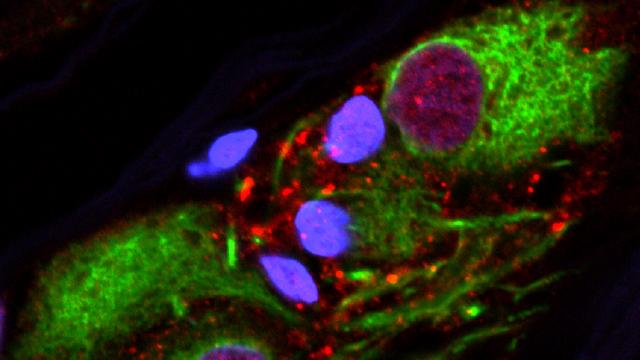Scientists have found further evidence that the gut, or more specifically the appendix, might play a role in the development of Parkinson’s disease.
The international team of scientists reviewed two datasets, including a large registry from Sweden, and found that removal of the appendix was associated with a decreased risk of developing Parkinson’s disease. They also found that the human appendix contains clumps of a protein called alpha-synuclein in a form associated with the disease. There’s more work to be done, and the authors are not advocating that people preemptively remove their appendixes, but they hope that the research could provide a pathway towards treatment.
“There’s potential for [gastrointestinal]-tract based therapies that could block the formation and spread of alpha-synuclein clumps as future, early, and preventative treatments for Parkinson’s disease,” professor Viviane Labrie from the Center for Neurodegenerative Science at the Van Andel Research Institute in Michigan said in a press teleconference.
Parkinson’s disease is the relatively common but chronic nervous system disorder that can lead to tremors, difficulty moving, other motor system impairments, and even G.I.-tract related symptoms. Scientists are working on determining its causes (there could be multiple) but it appears it could have both genetic and environmental components, according to the Mayo Clinic. It affects 0.1 to 0.2 per cent of people in general, and 1 per cent of people over 60, according to one recent study. People with Parkinson’s disease have clumps in their brains called “Lewy bodies,” which contain substances including alpha-synuclein.
Scientists have increasingly wondered whether there are Parkinson’s disease triggers in the gut. For the new study, the scientists studied the role of the appendix in Parkinson’s by analysing medical records from the Swedish National Patient Registry, which contains health records on approximately 1.7 million people, and the smaller Parkinson’s Progression Markers Initiative, which contains records on 849 Parkinson’s cases.
The study found that of the 1,144,745 Swedes who did not have appendectomies, 1,608 had Parkinson’s, but of the 551,003 who had, only 644 had Parkinson’s. This is amounts to a 16.9% decrease in the odds of acquiring the disease—but in absolutes, that’s the difference between an 0.14 per cent chance of acquiring the disease for those who hadn’t gotten their appendix removed versus an 0.11 per cent chance for those who had. The effect was also stronger in those living in rural areas, according to the study published today in Science Translational Medicine.
The researchers also found that for those who had appendectomies at least 30 years before developing Parkinson’s, the procedure was associated with a 3.6-year delay in disease onset.
But why? The team further analysed surgical human appendix samples and found that they contained alpha-synuclein proteins—including shortened and mis-folded alpha-synucleins like the ones found in Lewy bodies.
Perhaps, and according to experimental evidence, “it can travel up the nerve that connects the G.I. tract to the brain,” says Labrie. “And if it were to enter the brain, it can seed and spread from there and have neurotoxic effects that could eventually lead to Parkinson’s disease.”
University of Pennsylvania neuroscience and geriatric medicine professor John Trojanowski, who was not involved in the study, thought it was excellently done and agreed with the paper’s statement that the appendix is a source of mis-folded alpha-synuclein that could be targeted for therapeutic strategies.
John Woulfe, a scientist from the Ottawa Hospital Research Institute’s Neuroscience Program, said: “This research is important because it provides some support for the idea that Parkinson’s disease may be initiated outside of the brain and, specifically, in the appendix.” He said he found the study results convincing.
However, Woulfe mentioned that not all investigators agree that these protein clumps spread along the nerves. Additionally, he would have liked to see more information on how the age when the appendectomy was performed changed the risk of developing Parkinson’s disease, as well as potential reasons for the differing effect in rural areas.
Again, don’t go removing your appendix just yet. Labrie said that the appendix was just one possible place for the disease to start, but there are likely other origin points. Removing the appendix doesn’t completely eliminate the risk, and it’s normal for the clumped proteins to appear in the appendix. Given the appendix’s potential role in maintaining the gut microbiome as well as in the immune system, perhaps there’s actually some link between fluctuations in the microbiome or inflammation and Parkinson’s as well, said Labrie. That’s a subject for future study.
But this is a potential avenue for treatment, and drug companies are interested in targeting the protein in people who already have Parkinson’s, Patrik Brundin, director of the Center for Neurodegenerative Science at the Van Andel Research Institute, said in the teleconference.
So, it’s not a cure, but it’s a fascinating new avenue for research.
[STM]
